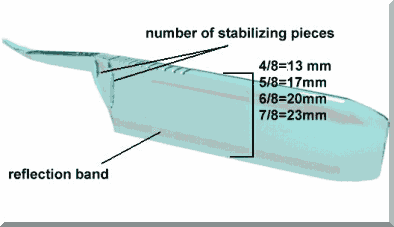Summary

razor size
In general, the wider ones (6/8 and 7/8") have more torsional stability, making them more suitable for heavy work. As the distance between edge and back is greater than in 4/8 and 5/8" blades, the edge angle remains more constant during its life. Stropping and honing is easier with larger blades, because the plane of contact between blade and medium is wider, hence the position more stable. Compare this with a tripod. The tilt of the blade on any surface is better visible with larger blades. The higher weight - pressure ratio in larger blades gives more stability. The small blades may be of advantage for the beginner; however, the experienced may prefer the large blades. A small blade apparently increases precision, but this is not true.
form
Spikes have no function. They were removed by professional barbers in the past, because they are dangerous and do not increase precision. Most points are rounded. Furher, form is a matter of taste and stability.
geometry
Full hollow grind has one advantage: it remains sharp with stropping a long time, and it is relatively easy to hone. At the other extreme of the spectrum is the wedge shaped blade. This is excellent for very heavy work, but honing takes a few minutes longer, because you must remove more metal to restore the edge.
material
Most modern razors are good. You will not have to bother about steel quality, hardening procedures, etc. May be this statement is not true. Stain resistant steel keeps its edge longer than high-carbon steel. May be this is not true either, although there is some evidence. However, the edge of high - carbon steel will show rust holes on electron microscopy within a few minutes after contact with water. Therefore, stainless razors may be the best choice. Do not use a plated razor, they are bad. The best handles in terms of durability and form-resistance are the resin impregnated wooden ones. Horn and plastic may deformate, causing the edge to touch the handle.
strop
It should be as wide and as long as possible, and made of Juchten. Horsehide is vulnerable and may crack. A hanging strop is preferrable because it keeps its form, and can be kept under tension. The other side must be hemp or canvas.
paste
Use paste to conserve a strop, but not as a lapping compound. It should have no cutting properties. There is only one good paste, which is the yellow one, which may be used on both the canvas and the leather side. Be sure they do not sell you the white paste instead, because it is not the same as yellow. If you doubt, just use a little olive oil, once or twice a year.
hone
Much has been written about hones, oil, and water, but there is little helpful evidence. However, with an #8000 Chromium Oxid waterstone, such as the Northern Mountain, or an Alu oxid Takenoko, you start with a fresh surface every time. The disadvantage might be rapid wearing when used for carving tools or heavier knives, but this problem does not occur with razors. The #8000 stones are used by Japanese razor sharpeners. Avoid natural stones quarried after 1900 because the inclusion bodies may damage the edge.
sharpening
Daily stropping and honing 1-4 times a year should suffice. Any action should be symmetrical and constant in pressure, speed, distance, angle, and tilt. Good function is the best test for sharpness, however, there are others to use during the sharpening process: the nail after honing and the thumb after stropping. Honing is done back-trailing, stropping edge-trailing.
brush
badger, see the Kent site.
pivot oil
Normal gun oil, or silicon containing oil.
original products
Musgo Real, Dominica Bay Rum from Callantilles, and Pinaud's Clubman.